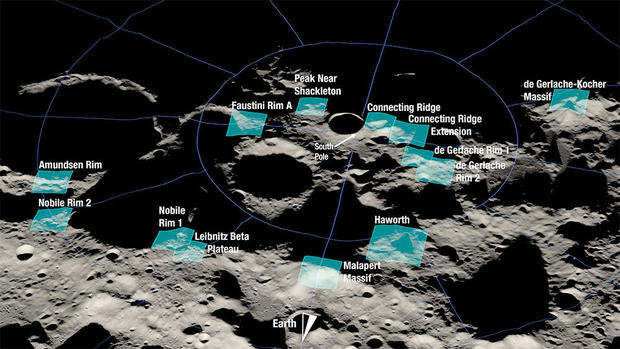NASA's future Artemis moon landing targets south pole, where shadowed craters may hold ice
NASA's return to the moon, the Artemis Program, is targeting future astronaut landings near the lunar south pole where ice may be present in permanently shadowed craters — a potential source of water, air and a ingredient in rocket fuel for future deep space explorers.
The program's first flight, Artemis 1, is an unpiloted shakedown mission for both the Space Launch System heavy lift rocket and the Orion crew capsule that will eventually carry astronauts back to the moon. The 42-day test flight was initially set for launch Monday, Aug. 29, but problems during the fueling process forced a delay.
If the first flight goes well, the Artemis 2 mission, expected to launch in the late 2024 timeframe, will carry four astronauts on a long loop around the moon and then back to Earth. That will set the stage for Artemis 3 in 2025 or 2026, a flight to put the first woman and the next man on the lunar surface near the moon's south pole.
Artemis astronauts also will collect samples and carry out geological studies while mapping the south polar region to learn more about the origin and evolution of the moon while using the missions as a testbed for life support systems and advanced technologies that will be needed for eventual flights to Mars.
But getting to the moon in the near term is challenging enough, especially getting astronauts into the polar orbits required for descents to the south pole region.
Keeping it "simple," the first two Artemis missions will stick with generally equatorial trajectories, flying behind the moon as viewed from Earth, into and out of contact with mission controllers.
But for the Artemis 3 mission and subsequent flights to the surface, NASA planners have settled on what's known as a near-rectilinear halo orbit, or NRHO, a hugely elliptical polar orbit with a low point, or perilune, of about 1,000 miles and a high point, or apolune, of roughly 43,000 miles above the moon's south pole.
It's an orbit Orion spacecraft can reach — its service module engine is not powerful enough to fly directly into a low-altitude circular orbit — and it offers a few clear advantages over a more familiar equatorial orbit.
First and foremost, Orion astronauts can reach the moon's poles. In addition, capsules in a lunar NRHO will remain in direct line of sight with Earth throughout each trip around the moon, ensuring uninterrupted communications. And with no eclipses, a spacecraft's solar arrays remain in constant sunlight.
"NRHO enables global lunar access," said Nujoud Merancy, chief of the Exploration Mission Planning Office at the Johnson Space Center. "It's highly fuel efficient, especially when compared to other types of orbits around the moon."
The Artemis architecture calls for building a small space station, Gateway, in a near-rectilinear halo orbit that will be equipped with solar-electric propulsion, a habitation module, an airlock and docking ports.
Astronauts in the Orion crew module, launched atop SLS boosters, will fly into the NRHO, dock with the Gateway and move inside. Unlike the International Space Station, Gateway can only support relatively short stays with a limited number of crew members, but it will offer an ideal research platform for studying the moon in detail.
"NRHO will give Gateway a continuous line of sight or view of Earth, so we get uninterrupted communication," Merancy said. "And as the Gateway vehicle travels in deep space, its presence opens up a lot of opportunities for radiation (research) and the greater analysis of space weather on people and instruments for future exploration."
But for the first landing mission, Artemis 3, Gateway will not be ready for use. Instead, NASA gave SpaceX a sole-source $2.9 billion contract to develop a variant of its Starship rocket to serve as a lander.
Instead of docking with Gateway, the Artemis 3 Orion will dock with the Starship in lunar orbit and two astronauts will descend to the surface from there. SpaceX plans to launch an unpiloted test mission before the Artemis 3 crew arrives.
Other companies are developing designs for follow-on landers. How that might play out remains to be seen, but NASA appears to be committed to building the Gateway space station, which also could be used for lunar research missions that do not include a landing.
NASA is sponsoring a small satellite mission, called CAPSTONE, to serve as an Artemis pathfinder of sorts. Launched in June from New Zealand atop a Rocketlab booster, CAPSTONE will arrive in a near-rectilinear halo orbit around the moon in mid December. It is designed to collect data on the radiation environment and lighting while testing communications.
In August, NASA identified 13 candidate landing sites within range of permanently shadowed craters or depressions that will give Artemis moonwalkers an opportunity to explore and look for signs of ice while still benefitting from continuous sunlight nearby.
"Selecting these regions means we are one giant leap closer to returning humans to the Moon for the first time since Apollo," Mark Kirasich, a senior planner at NASA Headquarters, said in a statement. "When we do, it will be unlike any mission that's come before as astronauts venture into dark areas previously unexplored by humans and lay the groundwork for future long-term stays."
Jacob Bleacher, chief exploration scientist for NASA, said the Artemis astronauts will help the agency develop a "blueprint for exploring the solar system."
"Lunar water ice is valuable from a scientific perspective and also as a resource, because from it we can extract oxygen and hydrogen for life support systems and fuel."







